Every survivalist knows the rule of three: A human can survive three minutes without air, three hours without shelter, three days without water, and three weeks without food. But when one of those essential resources for survival becomes contaminated, there may be side effects down the road. That is what the recent “Resource in Crisis” event held on Winona State University’s campus sought to address. In the last couple of years, many sources of water in the Winona area have tested above the acceptable 10 ppm rate for nitrates, a chemical compound that can create carcinogens in the body’s natural processes.
A special task force has been put together to inform people, bring attention to, and hopefully solve this issue. The Clean Water Coalition in collaboration with the Women’s League of Voters hosted the “Resource in Crisis” event to let the community know the extent of the damage caused so far, and the potential for more damage in the future.
The first warning sign given to the Winona area was the recent spike in fish kills seen in the Winona watershed area. Almost 5,000 fish have been killed in the last years, a sure sign that something is off within the ecosystem. This is particularly concerning as the largest individual kills have sloped upward over the years going from 250 in 2019, to 1,500 in 2021, to 2,500 in 2022. All these kills were at least in part linked to overexposure to nitrates in the water.
Of course, fish are not the only ones to be affected by contaminants in the water. Dr. Aleta Borrud, a retired physician who serves on the Clean Water Coalition, spoke about the potentially harmful effects that nitrates in the drinking water can have on humans.
“The first warning signs are the babies,” Borrud said. “When a fetus is exposed to high levels of nitrates, they develop Methemoglobinemia, which can be life-threatening.”
Borrud went on to explain that this condition causes the blood to lose its ability to carry oxygen around the body. It typically causes the skin to turn a blue color as a result. But that is just the beginning. Adult exposure brings its own complications as nitrates have been proven to react in the body’s natural systems to produce carcinogens.
“Nitrates in excess of 5 mg (about half the weight of a grain of table salt)/L have been shown to increase risk of thyroid, bladder, and ovarian cancers and another study found in excess of 3.07 mg/L can cause colorectal cancer,” Borrud said. “These studies also found that increased levels of nitrates led to an increased risk of cancer.”
These statistics are very alarming, but not all is lost. Throughout the whole event, one cause of nitrate pollution was brought up repeatedly. Agriculture. Specifically fertilizing crops and ways to mitigate contamination of the surrounding area. Nitrates can be contained in manure, pesticides, and all sorts of other artificial fertilizers. Many of the fish kills in recent years have been traced back to an excess of manure getting into the water. Mike Rupprecht, an organic farmer on the Clean Water Coalition, has intimate knowledge of how to limit nitrate pollution.
“We practice regenerative agriculture which seeks to imitate how nature functioned before human interference,” Rupprecht said. “We utilize rotational grazing, natural fertilization, and crop rotations to ensure that there is little to no nitrate contamination.”
By allowing the cattle to naturally fertilize the crop fields, Rupprecht has eliminated the need for pesticides and artificial fertilizers. His yearly crop rotations ensure the efficient use of nitrates within the soil while maintaining soil health and the ability to continue farming in the future. Rotational grazing allows for additional soil health and equal opportunity for all plants in the pasture to survive, not just the cows’ least favorites. In addition to these environmental benefits, the economic payback can be hefty.
“A well-managed rotation can be twice as effective as traditional farms, if not more,” Rupprecht said. “And that’s not mentioning the savings on pesticides and fertilizers.”






















































